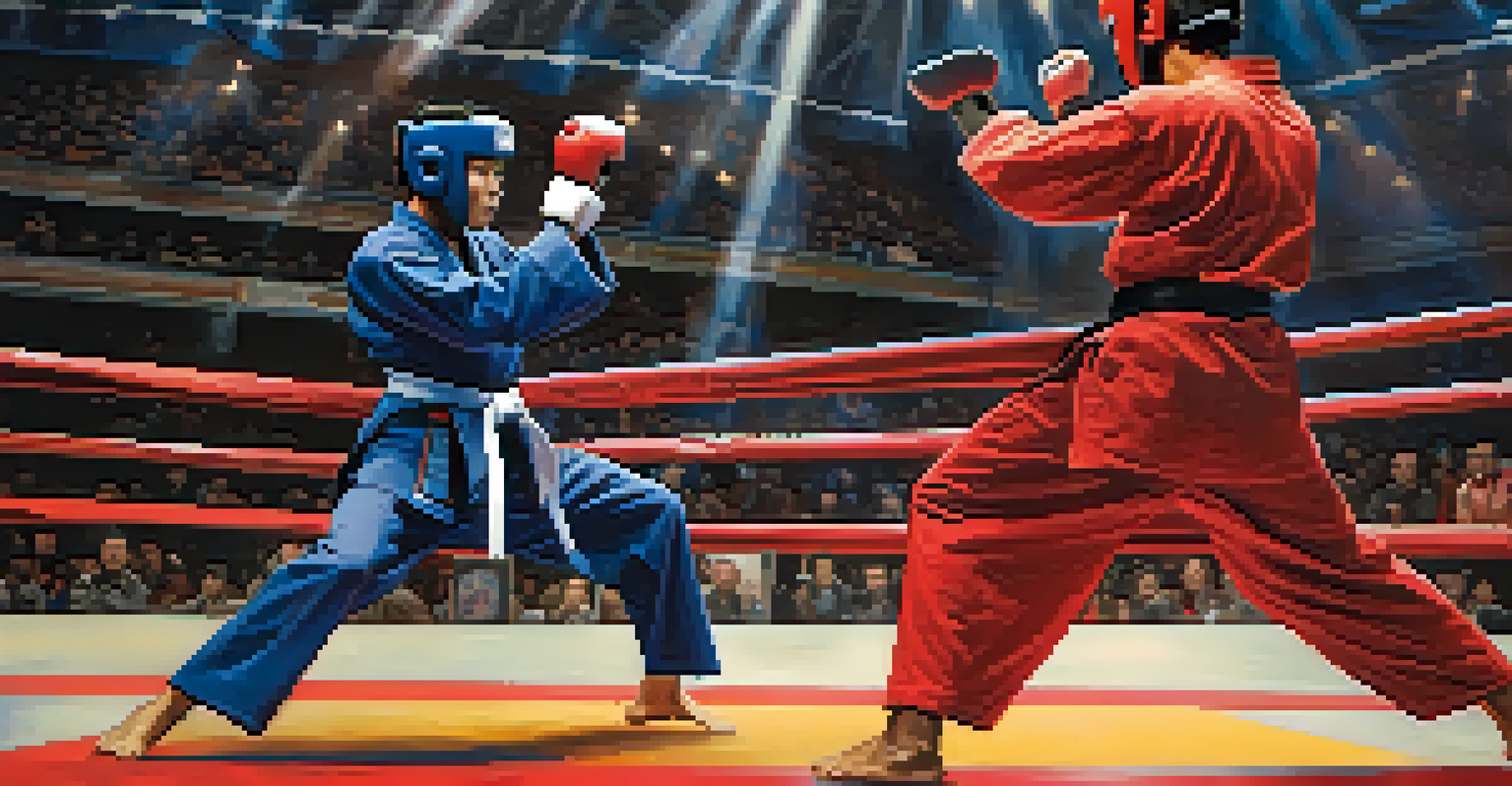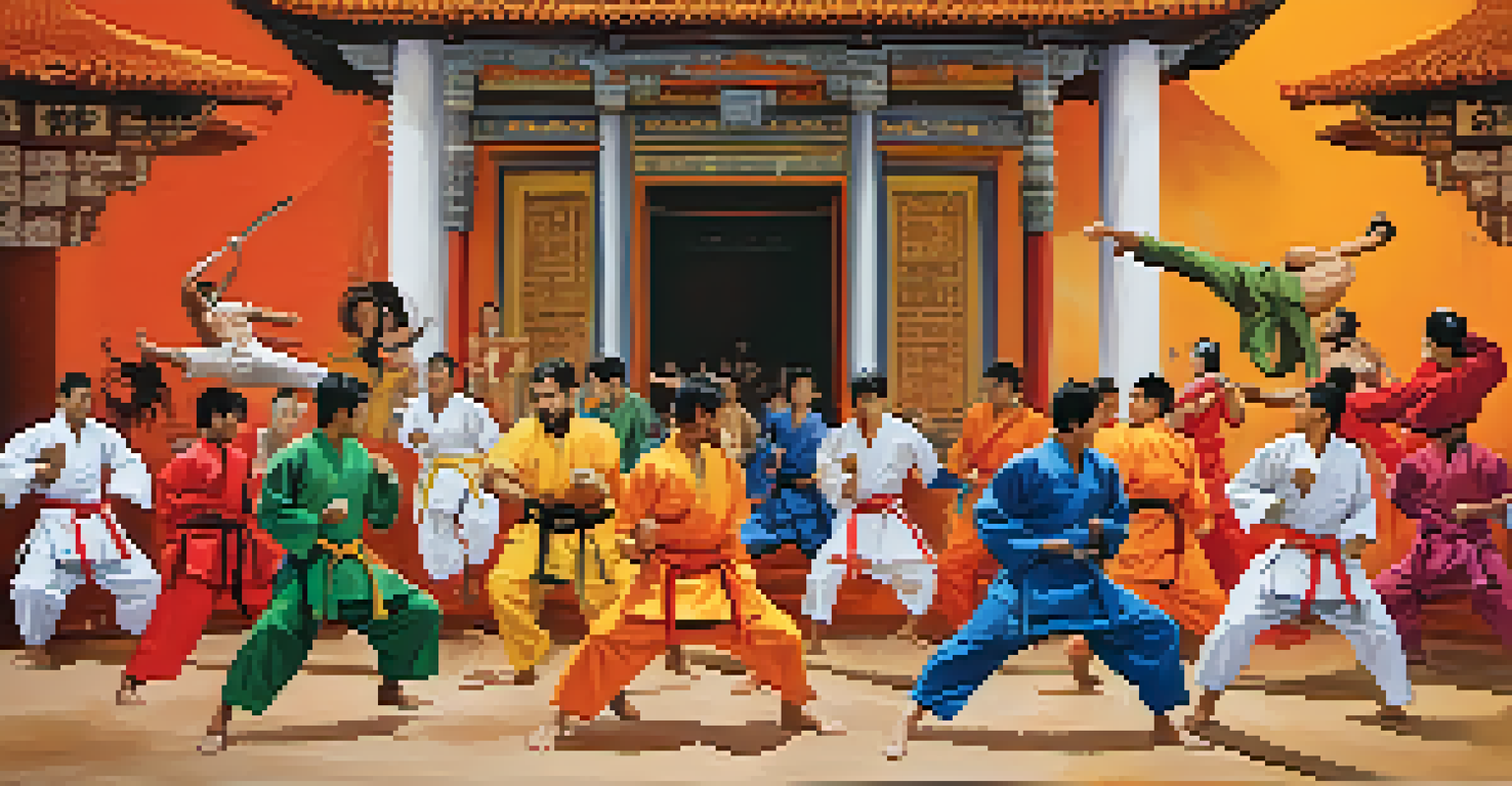The Evolution of Martial Arts Through History

Origins of Martial Arts: Ancient Beginnings
Martial arts trace their roots back thousands of years, primarily in Asia. Ancient texts from China, India, and Japan mention combat techniques used for self-defense and military training. These early forms were often influenced by the cultural and philosophical beliefs of their regions, shaping their practices and purposes.
Martial arts is not about fighting; it's about building character and integrity.
For instance, the Indian martial art of Kalaripayattu is believed to date back to 3rd century BCE and focuses on both physical and spiritual development. Similarly, Chinese martial arts, known as Wushu, have evolved from ancient battlefield tactics to integrated systems encompassing health, philosophy, and self-discipline.
As societies developed, so did these combat forms, morphing into structured styles that reflect the values and needs of their cultures. This diversification laid the groundwork for the vast array of martial arts we see today.
The Influence of Philosophy and Religion
Philosophy and religion played a significant role in shaping martial arts across different cultures. In many Asian societies, martial practices were intertwined with spiritual beliefs, emphasizing discipline, respect, and inner peace. For example, the practice of Tai Chi not only serves as a form of self-defense but also promotes harmony between body and mind.

Similarly, Buddhism influenced the development of various martial arts, encouraging practitioners to cultivate compassion and mindfulness alongside their fighting skills. This blend of physical prowess and spiritual growth created a holistic approach to martial training, appealing to both warriors and scholars.
Martial Arts' Ancient Roots
Martial arts originated thousands of years ago, with early forms influenced by the cultural and philosophical beliefs of regions like Asia.
As martial arts spread globally, these philosophical aspects helped to attract a wider audience, emphasizing personal development and self-discovery rather than mere combat.
Martial Arts in the Age of Empires
As empires expanded, so did the exchange of martial techniques and philosophies. The Silk Road, for example, was not just a trade route for goods but also a conduit for cultural and martial practices. Warriors from different regions shared their knowledge, leading to the evolution of hybrid styles.
The ultimate aim of martial arts is not having to use them.
During this time, various forms of martial arts began appearing in Europe, influenced by the knightly combat traditions. The introduction of fencing and other European martial arts laid the groundwork for modern combat sports, showcasing the adaptability of martial techniques across different cultures.
This era highlighted the importance of martial arts as a means of not only physical defense but also cultural exchange, fostering a sense of global interconnectedness.
The Birth of Modern Martial Arts
The late 19th and early 20th centuries marked a significant turning point in the history of martial arts. Traditional schools began to formalize their teachings, establishing clear lineages and codifying techniques. This standardization allowed martial arts to gain recognition beyond their countries of origin.
For example, Judo was founded in Japan in 1882 and quickly spread worldwide, becoming the first martial art to be included in the Olympic Games. This recognition paved the way for other martial arts, such as Karate and Taekwondo, to gain international prominence.
Cultural Exchange in Martial Arts
As empires expanded, martial arts evolved through the exchange of techniques and philosophies, fostering a sense of global interconnectedness.
The modern era also saw the rise of martial arts competitions, creating a platform for practitioners to showcase their skills. This competitive spirit contributed to the popularity and evolution of various styles, leading to the emergence of new forms like Mixed Martial Arts (MMA).
Martial Arts and Popular Culture
In the mid-20th century, martial arts began to infiltrate popular culture, largely due to films and television. Iconic figures like Bruce Lee and Jackie Chan brought martial arts to the forefront, captivating audiences worldwide. Their films not only showcased incredible fighting techniques but also highlighted the philosophy behind martial arts.
This surge in popularity led to an increased interest in martial arts training, with schools popping up across the globe. People from all walks of life were drawn to the discipline, fitness, and self-defense aspects of martial arts, making it more accessible than ever.
As martial arts became a staple in movies, it also influenced fashion, music, and even video games, creating a cultural phenomenon that continues to thrive today.
The Globalization of Martial Arts
Today, martial arts have truly become a global phenomenon, transcending cultural boundaries. With the advent of the internet and social media, practitioners can connect with others from different countries, sharing techniques and experiences. This globalization has led to the fusion of styles, resulting in innovative approaches to training and competition.
Furthermore, the rise of organizations promoting international competitions, such as the World Karate Federation and the International Brazilian Jiu-Jitsu Federation, has helped to standardize rules and practices across borders. This has enabled martial artists to compete on a global stage, fostering camaraderie and mutual respect among practitioners.
Modern Martial Arts Evolution
The late 19th and early 20th centuries marked a turning point, leading to the formalization of martial arts and their global recognition through competitions and media.
The accessibility of online training resources has also democratized martial arts, allowing anyone with an interest to learn from experts worldwide, regardless of their location.
The Future of Martial Arts: Trends and Innovations
As we look to the future, martial arts are poised to continue evolving. One trend is the increasing integration of technology, such as virtual reality training and online classes, which can enhance the learning experience. These innovations make martial arts more engaging and accessible, particularly for younger generations.
Moreover, the growing emphasis on mental health and wellness has led to a greater focus on the therapeutic benefits of martial arts. Many practitioners are now exploring how martial arts can serve as a tool for stress relief and personal growth, further broadening its appeal.

As new styles emerge and existing ones continue to adapt, the future of martial arts promises to be as dynamic and diverse as its rich history.